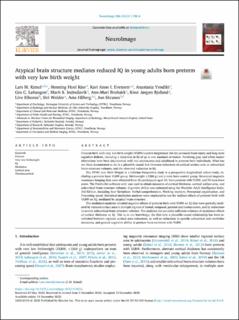| dc.description.abstract | Preterm birth with very low birth weight (VLBW) confers heightened risk for perinatal brain injury and long-term cognitive deficits, including a reduction in IQ of up to one standard deviation. Persisting gray and white matter aberrations have been documented well into adolescence and adulthood in preterm born individuals. What has not been documented so far is a plausible causal link between reductions in cortical surface area or subcortical brain structure volumes, and the observed reduction in IQ.
The NTNU Low Birth Weight in a Lifetime Perspective study is a prospective longitudinal cohort study, including a preterm born VLBW group (birthweight ≤1500 g) and a term born control group. Structural magnetic resonance imaging data were obtained from 38 participants aged 19, born preterm with VLBW, and 59 term-born peers. The FreeSurfer software suite was used to obtain measures of cortical thickness, cortical surface area, and subcortical brain structure volumes. Cognitive ability was estimated using the Wechsler Adult Intelligence Scale, 3rd Edition, including four IQ-indices: Verbal comprehension, Working memory, Perceptual organization, and Processing speed. Statistical mediation analyses were employed to test for indirect effects of preterm birth with VLBW on IQ, mediated by atypical brain structure.
The mediation analyses revealed negative effects of preterm birth with VLBW on IQ that were partially mediated by reduced surface area in multiple regions of frontal, temporal, parietal and insular cortex, and by reductions in several subcortical brain structure volumes. The analyses did not yield sufficient evidence of mediation effects of cortical thickness on IQ. This is, to our knowledge, the first time a plausible causal relationship has been established between regional cortical area reductions, as well as reductions in specific subcortical and cerebellar structures, and general cognitive ability in preterm born survivors with VLBW. | en_US |

